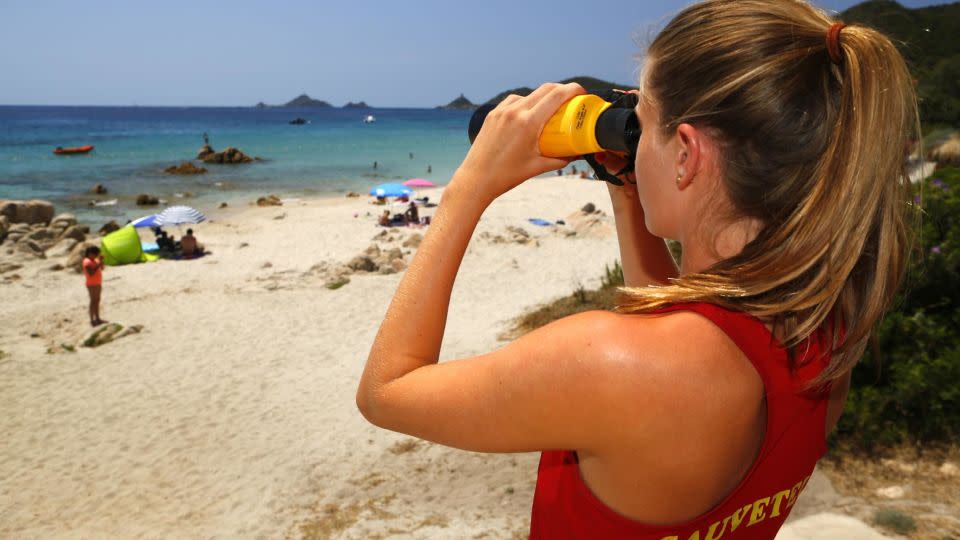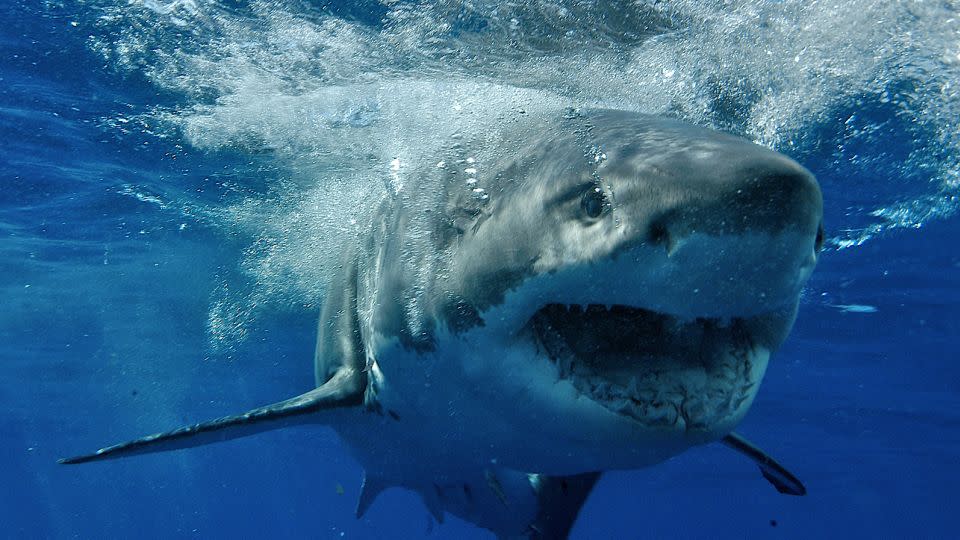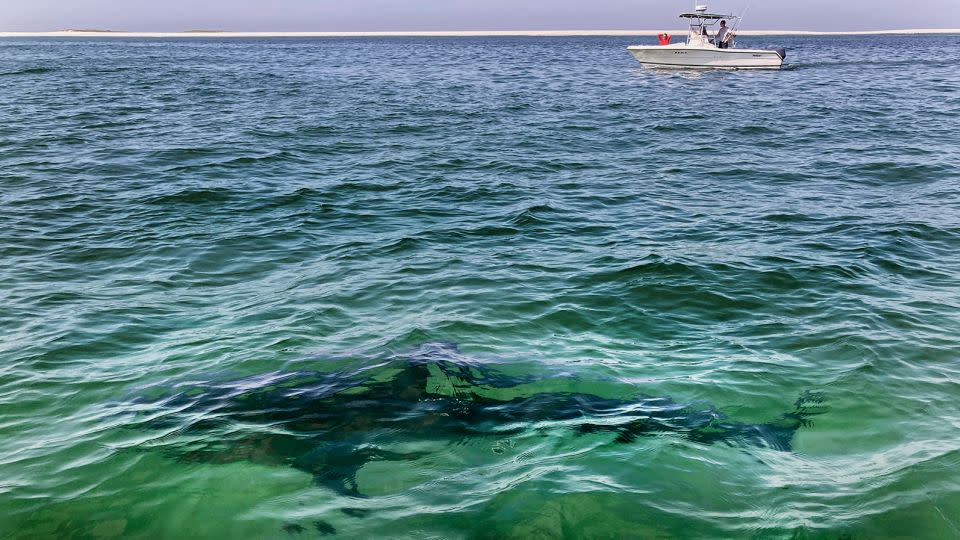How to survive a shark attack – or better yet, avoid one entirely
First things first. Despite some truly terrifying tales of survival, you are incredibly unlikely to be duking it out with a shark any time soon.
But sharks do occasionally attack humans – and they certainly make news when they do:
• A man was recovering in mid-July after being bitten by a shark off Key West in Florida
• A 14-year-old boy was bitten in the leg by a shark at a North Carolina beach in late June 2024.
• A lifeguard and surf instructor, who also appeared in “Pirates of the Caribbean: On Stranger Tides,” died after an apparent shark attack on the North Shore of Oahu, Hawaii, in late June 2024.
• Florida fire officials asked beachgoers to exercise caution in early June 2024 after three people were injured in two separate shark attacks within just 90 minutes of each other at neighboring Walton County beaches.
• A woman was bitten by a bull shark in Sydney Harbour not far from the city’s iconic Opera House in January 2024. And a Russian citizen was killed by a shark in the Red Sea in Egypt on June 2023.
While these kinds of encounters understandably cause would-be ocean swimmers to worry, there’s no need to panic about your upcoming beach vacation. The chances of being attacked by a shark are extremely low despite the headlines.
The Florida Museum of Natural History’s International Shark Attack File found just 69 confirmed, unprovoked shark attacks on people and 36 confirmed bites worldwide in 2023. That compares with 57 confirmed, unprovoked shark bites on people and 32 bites in 2022.
Think about it a minute – the world population is more than 8 billion people. Many of those live near or vacation at the coast. And that’s all the shark attacks recorded. Your chances of drowning are much, much higher.
In 2023, the United States once again led the way in unprovoked attacks in 2023 at 36; Florida had the highest state total at 16.
That said, you can take steps to increase your chances of survival during a highly improbable attack, according to shark experts interviewed by CNN Travel.
Before you get in the water
Know your environment
Sharks are salt-water creatures. The ocean is their home; we are the visitors.
“If you’re going to the ocean, you have to assume you could encounter a shark regardless of when or where that is,” said Neil Hammerschlag, director of the Shark Research and Conservation Program at the University of Miami Rosenstiel School.
“Fortunately, humans aren’t on the menu, and also fortunately, sharks tend to avoid people.”
Still, there are places you’re more likely to encounter a shark.
River mouths are not the best place to swim

You should avoid estuaries, said Richard Peirce, an author, shark expert and former chair of the UK-based Shark Trust and Shark Conservation Society.
Their often-murky waters are a favorite with bull sharks, which are the most likely to attack humans along with great whites and tiger sharks.
“An awful lot of attacks occur in river mouths, where there is silt and other material in suspension in the river – people washing their clothes, people washing themselves,” said Peirce.
Hammerschlag pointed out another area where an encounter is more likely: deeper channels between the shoreline and sandbars farther out.
Avoid areas with fishing
Before you jump in the sea, have a look around the horizon: What do you see? If you see fishing boats, Peirce says “forget it.”
“Whether the fishing activity is commercial or recreational, material will often be being discarded, and unwanted dead fish, fish parts and the action of gutting fish are all putting chum in the water and inviting attention from sharks,” he said.
Before you go in, watch for unusual fish activity, such as a whole bunch of small- and medium-sized fish jumping out of the water, Hammerschlag said. That’s a possible sign a shark might be nearby.
He also advised to not swim within roughly 50 yards of where someone is fishing from shore.
Avoid dusk and dawn
Swimming early in the morning or late at night can be lovely, but it’s also the time when a shark attack is most likely.
“A lot of shark attacks are cases of mistaken identity,” Peirce says, “due to reduced visibility and identification ability on the behalf of the shark.”
Hang with lifeguards

Chris Lowe, professor in marine biology and director of the Shark Lab at California State University, Long Beach, advises to “do your homework” before you go into unfamiliar waters. Bone up a little bit on species you might encounter in different places.
If you have any questions, ask a local lifeguard. He said they are a great resource.
“I always recommend people go to guarded beaches. It’s a lot safer,” he said.
Don’t wear shiny objects in the water
“Be careful with jewelry, anything that flashes because sharks are always looking for fish.” Lowe said.
In murky water, a shark may think that flash is a sign of a meal. “And you don’t want your hand or foot to get confused with that.”
Follow your instincts
“Probably the most important thing is to follow your gut,” Hammerschlag said. “If you feel wary about getting in the water … just don’t go in the water.”
“A lot of people who have been bitten actually said they had a weird sensation before that, like they had an inner voice telling them to get out of the water and they didn’t listen to it,” he said.
If a shark is nearby

Don’t panic
So you’re being circled by a shark. The worst thing you can do right now is panic.
“Don’t start splashing around – you’re just going to excite, incite and encourage the shark’s interest,” said Peirce.
Humans, apes, dogs and cats all have paws and hands. If we want to explore something we pick it up and we touch it, we feel it, we put it to our nose.
“A shark has got no paws or hands, so if it wants to explore something, the only capability it’s got to do that is to put it in its mouth,” said Peirce.
“That’s why we often get exploratory bites which don’t result in death and sometimes don’t even result in serious injury. If you go swimming and splashing away, you’re almost inviting the shark to come give you an exploratory or an attack bite.”
Maintain eye contact
As the shark swims around you, keep your head on a swivel and try to maintain eye contact.
“Sharks are ambush predators,” Peirce explained. “If you’re turning around and facing it the whole time while it circles you, it’s not going to be half as comfortable as if it’s able to sneak up from behind.”
Hammerschlag concurred, saying you should posture your body toward the shark so it knows you see it and you’re following it. Then slowly back up toward your exit to a boat or shore.
If you’re surfing, track the shark with your board, Lowe said. “Let the shark know it’s being watched.”
Marine biologists and shark divers Adriana Fragola and Kayleigh Grant show how that eye contact method works with tiger sharks. In a viral TikTok video (see top of story), the shark is seen as Fragola splashes away, capturing its attention. She turns around, faces the approaching shark, remains still in the water and gently deflects the shark away with her hand.
“You’re definitely never going to outswim or outrun a shark if it were actually chasing you,” Fragola says in the video.
Stay big or get small
This is where it gets complicated. If a shark is clearly in attack mode, you need to make yourself as big as possible in the water, according to Peirce.
“The bigger you are in the water, the more respect you’ll get,” he said.
But if the shark seems to simply be passing through, Peirce’s advice is to roll up into a ball.
“If a shark sees you as a competitor for its food source, that can be one reason it attacks you,” he explained.
“If I didn’t want to be seen by a great white shark as a competitor – and if it wasn’t showing massive interest in me – I would actually curl up so he shows even less interest in me.”
If you’re being attacked
Don’t play dead
This isn’t a bear, it’s a shark. If you find yourself in an aggressive encounter, give it hell: punch, kick and poke at sensitive spots – but be careful where you aim.
“There’s all this talk about punching a shark in the nose. That’s OK, but remember that just underneath the nose is a mouth,” said Peirce.
“This is a moving object in the water and you’re not staying still either, so what you don’t want to do is end up effectively punching at the mouth or anywhere near it.”

A good shot to the gills can also do the job: “The gills are very sensitive – giving a shark a whack in the gills isn’t a bad idea.”
Are you carrying anything with you? If so, turn it into a weapon.
“If you’re a diver with an underwater camera, use it, if you’re a snorkeler, rip off your snorkel and use it to poke the shark,” Peirce says.
“I’ve had a lot of sharks come at me, and it’s (been) enough to use a shark billy – a small metal rod between two and three feet long – and I’ve just given them a little nudge on their nose.”
It’s a good idea to swim with other people, Lowe said. Not only does that decrease the chances of an attack, he said, but you’ve got someone to assist you to a boat or shore if you are bitten.
Cut off the angles

If you’re a diver and you run into trouble, try to get into a position where the shark can’t get behind you, says Peirce.
“Keep your back to something like a coral reef. Then you’ve only got one direction to look. You’re protected from behind, for example, and that enables you to keep the shark in sight in front of you and maybe swim to the top of the reef slowly to where your boat is.”
Slowly back away
Displace the least amount of water possible. Try not to thrash and splash around as you gradually swim backwards toward shore.
“You must try and keep the animal in sight and very slowly and gently try and swim backwards and get into shallow water. Again, you’ve got to be careful – large sharks can attack in very shallow depths.”
Doing the above may help to a degree, but Peirce says the likelihood of escaping without injury when a big shark attacks is slim.
“If a white shark is in full attack mode, there’s not much you’re going to be able to do at that point,” he says.
This article, first published in 2015, is updated periodically to report recent shark attacks.
For more CNN news and newsletters create an account at CNN.com


